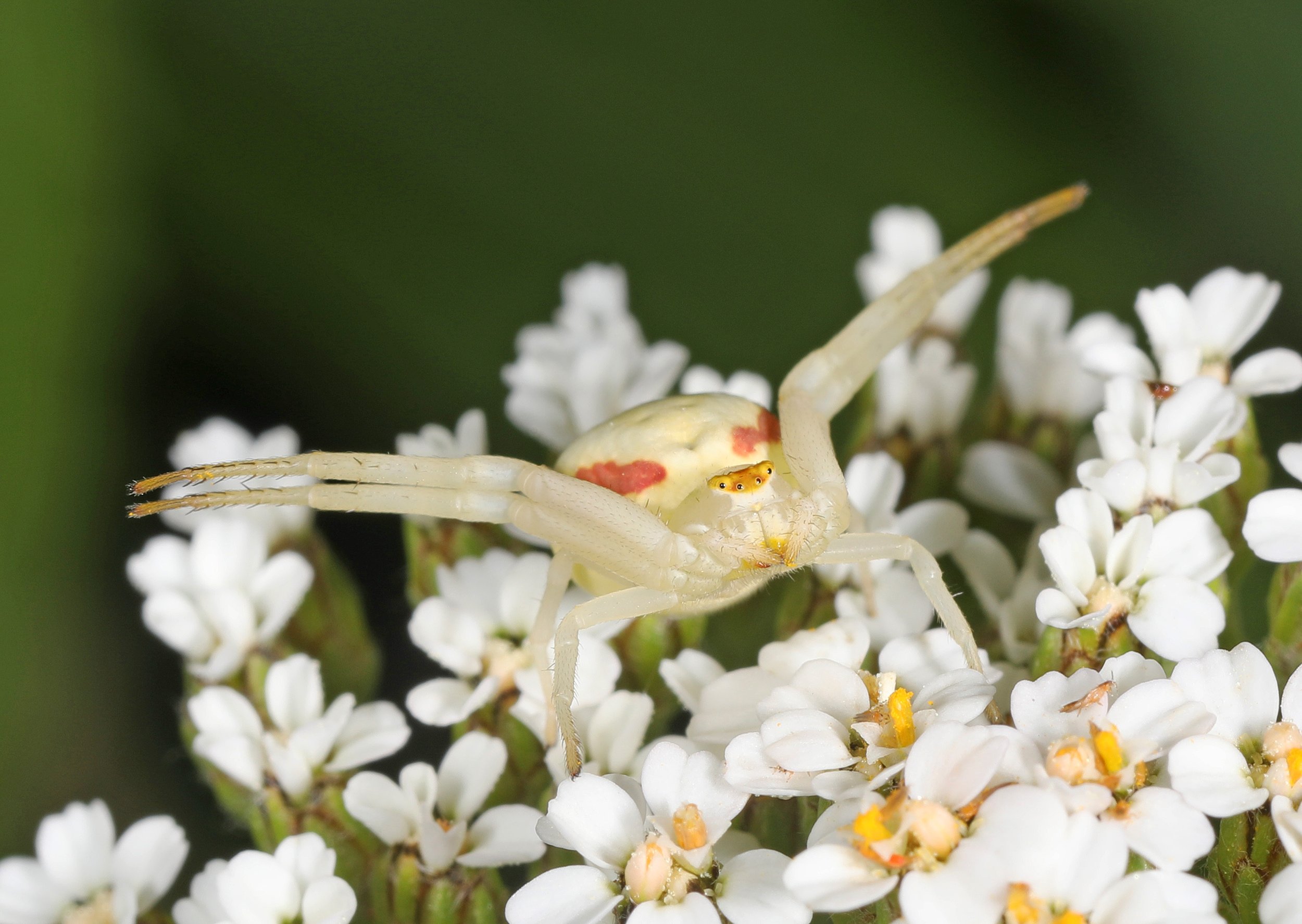Crab Spiders (Family Thomisidae)
Goldenrod Crab Spider (Misumena vatia). Photo by Judy Gallagher
The well camouflaged Goldenrod Crab Spider is holding it’s prey, a Hover Fly (Eristalis tenax), at the neck. Photo by Judy Gallagher
Not all spiders spin webs to catch their prey. Some, like crab spiders, depend on camouflage and patience to ambush a meal. Inspect the plants, and especially the flowers, in your garden carefully and you might find one of these stealthy predators lurking about. Some crab spiders are large enough to bite humans, but their venom has little effect on us and getting bitten is unlikely unless you handle the spider.
Identification: Crab spiders have a very distinctive stance when at rest, holding their first, second, and third pairs of legs stretched out from their sides (laterigrade), in a crab-like fashion. Their legs are relatively short and robust compared to many spiders. The first two pairs of legs are longer than the third and fourth pairs and are raptorial, meaning that they are adapted to grasp prey. The first pair of legs on some species are armed with stout spines. Crab spiders can use their legs to move from side to side as well as backwards and forwards. Overall body length ranges 5-10 mm, with females being larger, often much larger, than males. The abdomen (rear body segment) is somewhat oval and much larger than the cephalothorax (front body segment). The cephalothorax has sides of roughly equal length and is somewhat flattened, while the abdomen is often a bit plumper. They have two curved rows of four small, simple eyes each on the front of the cephalothorax, visible on larger individuals.
Their eyesight is relatively good for spiders, enabling them to detect motion, though not clear images, up to 20 cm away. Many crab spiders are brownish and cryptically patterned, but others are brightly colored, with white, pink, yellow, or orange to blend in with flowers. Some, such as the Goldenrod Crab Spider (Misumena vatia), can change color to match the flowers they are on, though this change occurs over a period of days to weeks.
Range: Crab spiders are found throughout our region.
| What Crab Spiders Need | How Can We Help |
|---|---|
| Food and Water: Crab spiders obtain food and water primarily from their prey, which includes mostly insects, but also other spiders. Some also reportedly supplement their diet with nectar and pollen. They are ambush predators and use their raptorial front legs to seize nearby prey, then deliver venom with a bite from their fangs. The venom paralyzes and begins to digest the prey, allowing the spider to suck out the prey’s liquified tissues. Depending on the species, crab spiders find prey on the ground, in leaf litter, on trees and shrubs, and in herbaceous vegetation, especially flowers. Crab spiders take large numbers of pollinators and other flying insects. |
|
| Shelter: Depending on the species, crab spiders seek shelter in leaf litter, herbaceous vegetation of various types, shrubs, and trees. They depend primarily on camouflage to hide from predators, including birds, other spiders, predaceous insects, and parasitic wasps. |
|
| Breeding: Mating and egg-laying occurs in late-summer and fall. Males of some species cover their mates with a few strands of silk, called a bridal veil, as part of their courting ritual. The female lays her eggs in flat silk egg sacs attached to plants and guards them until they hatch, or she dies. Eggs hatch the following spring. |
|
Additional Resources:
Some flowering plants can attract crab spiders with a floral scent when under attack by herbivorous insects. This is the same scent flowers use to attract bees. Both the plant and the crab spider benefit from this relationship, making it an example of mutualism. Find more information here.



